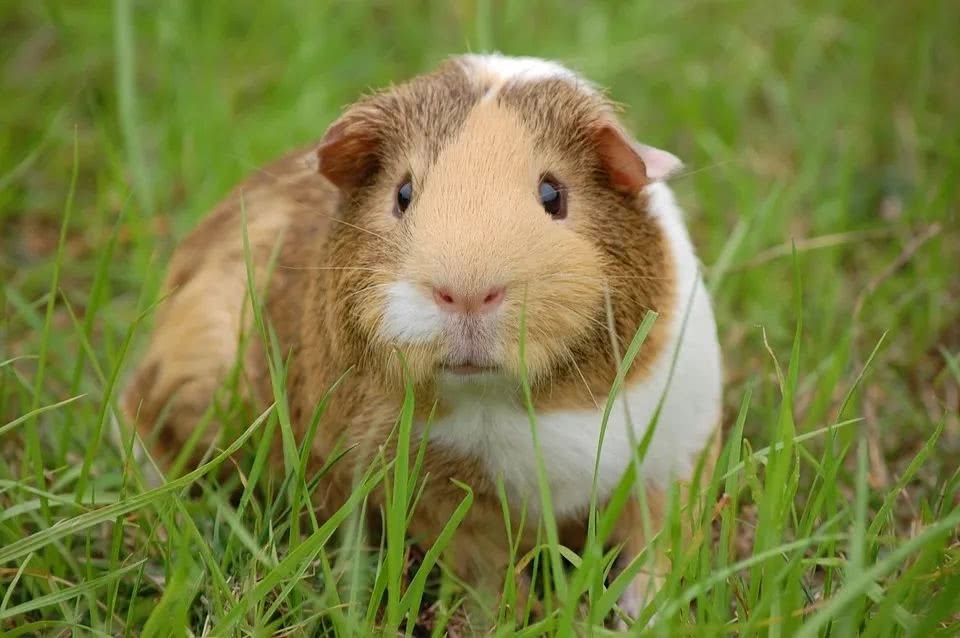What kind of experience is eating poop? Dutch Pig: I have something to say

I like birds, but I am generally interested in mammals and rodents, so I didn't pay much attention to animals such as hamsters and guinea pigs when I was a child.
Until I was in college, many guinea pigs were needed to do experiments in animal physiology class, and the students thought it was relatively novel, so Xiao Zhao in the dormitory went to the laboratory to "save" several guinea pigs and kept them in the dormitory-- Xiao Zhao himself, me, and Gao Pang classmate in the bed next to me. Every night we would put the three guinea pigs together to interact, and each time my guinea pigs would be chased around by Xiao Zhao's guinea pigs to try to mate, while the tall and fat guinea pigs watched with a bewildered face.
I gradually feel that it is quite interesting to raise guinea pigs, and I will certainly take good care of them when I have a place in the future.
A guinea pig from the lab. Picture: red-billed blue magpie
Guinea pigs with a long history
Perhaps many friends will be stupefied when they hear the name "guinea pig", because we are often more familiar with its other names-Dutch pig, guinea pig and guinea pig. "Guinea pig" is its more formal name (so the Dutch pig is a rat, not a pig), and the name also reflects its classification: rodents, guinea pigs, guinea pigs.
Guinea pigs, like mice, squirrels and hamsters, are rodents with iconic incisors. Picture: pixabay
The guinea pig family (guinea pig genus) includes several wild guinea pigs, which are found only in the mountains of South America. After arriving in South America in the 13th century, Spaniards began to cross, domesticate and artificially select several kinds of wild guinea pigs. After the 16th century, the pedigree of these hybrid guinea pigs gradually stabilized and were brought back to Europe. And quickly become very popular pets.
In the 18th century, the domesticated guinea pig was recognized as an independent species and given the scientific name Cavia porcellus. At this point, guinea pigs are officially distinguished from their wild ancestors, such as the prairie guinea pigs (C. tschudii) in South America.
Guinea pigs have two commonly used English names: Guinea pig and Cavy (the former corresponds to Guinean Pig). In European and American pet circles, guinea pigs are often called "piggy", similar to domestic nicknames (many people call their guinea pigs pigs). As to why pigs should be named after the unrelated "Guinea", opinions are still divided and there is no clear answer.
Guinea pig: "my hometown is South America." Picture: pixabay
Guinea pigs and humans
In recent hundreds of years, guinea pigs have a very close relationship with human beings. In addition to being domesticated as pets for a long time, guinea pigs are also important medical and biological experimental animals.
From the experimental point of view, guinea pigs have numerous advantages, such as low feeding cost, easy reproduction, very sensitive to many pathogens, some physiological structures similar to human and so on. Like humans, guinea pigs can not synthesize vitamin C independently and need to get food from the outside world, so guinea pigs are the most ideal experimental animals when conducting experiments related to vitamin C. As mentioned at the beginning of this article, the guinea pig I first met was carried out from the laboratory.
However, in their native Peru, guinea pigs are neither pets nor experimental animals, but a famous traditional food that is very popular. The local guinea pig festival is often held to select the largest and most beautiful guinea pigs, but the highlight of this festival is guinea pig barbecue.
Peruvian specialty food-guinea pig barbecue. Picture: wordpress.com
There are many kinds of pet guinea pigs.
Of course, I believe what you are most concerned about is the guinea pig as a pet.
From the 16th century to the present, after hundreds of years of hybridization and selection, there have been countless different-looking species of pet guinea pigs, and what you see in pet shops and search on the Internet is just the tip of the iceberg. According to the type and length of guinea pig hair, we can simply and roughly divide them into the following categories:
Types of hair: cis, reverse, curly, crown hair
The length of hair: short hair, long hair.
Generally speaking, different breeds of pet guinea pigs pair the hair length + types above. For example, the one closest to the wild type is "short shun" (short hair and smooth hair). The species with strange appearance and high appearance, such as long crown, long shun, long inverse and all kinds of curly hair, are more popular than ordinary short shun in the pet market, and the price is naturally much higher.
The fur colors of each of the above pet guinea pigs are very diverse, not only a variety of pure color individuals, such as pure white, pure black, pure brown, etc., but also many miscellaneous colors (ranging from two colors to four colors) and gradient individuals. Imagine that it would be interesting to raise a litter of colorful guinea pigs.
Swipe left and right to see several varieties of pet guinea pigs. Picture: pixabay & boredpanda
There is also a strange breed of guinea pigs that is hairless (similar to the style of the Sphinx cat), which I like to call "naked pig". Some of this breed is naturally hairless, while others are hairy at birth, and the hair fades with age.
How to get along with guinea pigs
After coming to New Zealand as a new doctoral student, Eagle Dance and I finally had our own home and room to raise animals, and the first thing I thought of was the cute guinea pig I met in college. "if you have a place in the future, you must take good care of it." Now that there is a place, how can it be regarded as "good care"? Let me take our pig "malt" as an example to talk about how to "raise" a guinea pig.
Let's meet. This is my pig malt, which is named after the budding white spot on her forehead. Picture: Eagle Dance
I have always thought that keeping pets is a very serious thing, and shoveling shit officials must be aware of spending a lot of time and energy on preparation and checking materials. When you see something cute, buy it home first, which is not only very dangerous to the animal itself, but also from the point of view of shoveling shit officials, incomplete information will also cause you to fail to experience the fun of feeding and interaction.
After spending a lot of time looking up numerous materials on the websites of China and New Zealand, I finally confirmed that my family's conditions can raise Dutch pigs: from the point of view of animal welfare, the recommended area of one pig here in New Zealand is not less than 0.7 square meters, while the recommended area of two pigs is 1.4 square meters, which can ensure that pigs have sufficient space for activities. Our family is relatively small, so we decided to keep only one.
We had arranged the pig's home in advance before we went to the pet store: a large feeding box with accommodation (wooden pigsty with closed side openings at the top) and dining area (grass and guinea pig food, as well as toilets); there is a long passage between the pigsty and the restaurant that requires turning and climbing, which ensures that the pig gets a certain amount of exercise at ordinary times.
The pig house with malt covers an area of 0.9 square meters, including a semi-enclosed dining area and square (1st floor), a semi-enclosed pigsty (2nd floor), and a three-story platform with towels for her to play. However, my family is full of exploration spirit of malt has developed its own fourth layer, can you find her? Picture: red-billed blue magpie
Malt is a black and white two-color sow, the breed is a common short shun. At ordinary times, her food is mainly unlimited hay and limited guinea pig food, as well as regular and limited supply of fresh grass, vegetables and fruits (such as parsley, carrots, kiwifruit).
In terms of nutrition, shoveling officials should first pay attention to the fact that pigs themselves cannot synthesize vitamin C, so usually they must provide vegetables and fruits containing vitamin C for supplement. In addition, it should be noted that Dutch pigs are easy to get stones, so it is not only necessary to ensure clean and unlimited drinking water, but also to control calcium intake, such as the popular staple grain alfalfa is high in calcium. Young pigs have no problem eating (because young pigs have a greater demand for calcium than adult pigs), but adult pigs eat too much alfalfa to get stones.
Malt was still adapting to the environment a few weeks before she entered our house, during which time we didn't give her much excitement or interact with her frequently. When she is familiar with us, she begins to slowly train her to listen to her name and often carry her out to play with her. By this time, she already likes us very much, so she can interact with us happily, such as eating and sleeping on our legs.
Malt will sleep in the nest, go to the dining area to eat, and will let 90% of the excrement appear in the toilet in the dining area. The picture shows malt sleeping on the leg of the eagle dance. Picture: Eagle Dance
In addition to accommodation and catering facilities, there are also some toys in the malt cage, that is, the so-called "abundant appearance", in order to fully satisfy its spirit of exploration and freshness, so as not to be too boring. For example, Eagle Dance fixed a pile of hanging strips of cloth at the entrance and exit of the pigsty. Malt loved it so much that we often pushed it back and forth. We also put a piece of wood on the edge of the pigsty for her to grind her teeth (the rodent's growing incisors need to be ground regularly). In addition, there will be some small pieces of wood of different shapes, and malt this play spirit likes to throw these pieces to play with, and then make a sound to attract our attention.
Malt is a pig with a great spirit of exploration and is curious about anything new. Picture: Eagle Dance
By the way, malt especially likes to eat shit, and likes to eat continuously. I once saw her eat 8 shit eggs in a row. Of course, this is the normal behavior of guinea pigs, they eat a soft dung ball, which contains a lot of useful nutrients (such as vitamins, cellulose and some fungi that help digestion). For pigs, eating shit helps to improve the efficiency of nutrient absorption.
The malt is eating shit. Picture: Eagle Dance
Finally, the guinea pig raised little tips.
A pig can live for 4 to 6 years, so please be prepared to accompany it for a long time.
Pigs lose a lot of hair, both long-haired and short-haired pigs, so if you are allergic to animal hair, please raise it carefully
Pigs will make all kinds of loud calls when they are hungry and excited. If the house is not soundproof, please raise it carefully.
Pigs also eat a lot of Dora, so it will be very delicious if the cage is not cleaned in time, and lazy cancer will be raised carefully.
Even after a period of environmental adaptation and deliberate training, not all pigs like to be touched.
Pigs often lick their own hair, so if you put skin care products or cosmetics on your hands, please do not come into direct contact with pigs.
The guinea pig is a lovely and intelligent animal. So if you give it enough love and attention, it will know and remember, and then use its infinite cuteness to give back to you.
This is the 231st article in the fourth year of the species calendar, from the author of the species calendar @ red-billed blue magpie.
If you like him, you can still follow him.
Birdlife
Id: birdslife
About birds, nature travel and nature conservation
- Prev

Then I. Let's have the baby right here.
The rabbit rubbed his eyes and walked out of the house and stretched himself. Flapping his ears, moving his legs and feet, he jumped twice. "it's another sunny day--" the rabbit stretched out and yawned and reached for the shovel by the door, but.
- Next

Sprinkle in the basin and run away all the gray mosquitoes. Ten bud basins burst in one day.
Friends who have lived in rural areas all know that corn, peanuts and other straws are used for cooking and burning in rural areas, and these burned straws are plant ash, which can prevent rotting, promote rooting, supplement potash, and control diseases and insect pests.
Related
- Wuhan Hospital Iron Tree Blooming Result Was Instantly Frightened by the Gardener Master
- Which variety of camellia is the most fragrant and best? Which one do you like best?
- What is the small blue coat, the breeding methods and matters needing attention of the succulent plant
- Dormancy time and maintenance management of succulent plants during dormancy
- Minas succulent how to raise, Minas succulent plant pictures
- What are the varieties of winter succulent plants
- How to raise succulent plants in twelve rolls? let's take a look at some experience of breeding twelve rolls.
- Attention should be paid to water control for succulent plants during dormant period (winter and summer)
- Watering experience of twelve rolls of succulent plants
- Techniques for fertilizing succulent plants. An article will let you know how to fertilize succulent plants.

